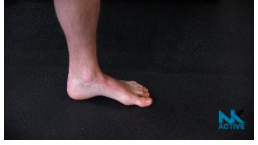
What is metatarsalgia?
In our last enewsletter, NK Active Podiatrist, Charlotte (Charlie) and our Exercise and Rehabilitation Instructor, Natalie wrote about metatarsalgia; what it is, some possible reasons for why this pain has developed in the forefoot are; as well some strengthening exercises used in the rehabilitation process.
What is metatarsalgia?
Metatarsalgia is an umbrella term used to describe pain across the plantar forefoot aspect of the feet or foot. This usually includes the toes as well.
Metatarsalgia is a term used when a diagnosis hasn’t yet been made. There are lots of conditions such as bursitis, neuroma, synovitis, capsulitis or a plantar plate injury that could cause pain and discomfort in the forefoot and toe area.
Finding out what is causing the pain or discomfort is important in order to determine what treatments could help ease your symptoms.
What causes pain or discomfort in the forefoot?
There are lots of possible reasons for why pain/discomfort has developed in the forefoot area: –
- Intense training or increase in activity volume – running and high impact activities can increase the force and pressure through the toes and forefoot area. If activity levels are increased too quickly, this can irritate and damage structures in the foot. A training or loading programme can help reduce the risk of this occurring.
- A high arched foot shape can place extra pressure through the metatarsals (toes).
- Foot deformities – having a bunion, retracted toes or hammertoes can change where the pressure and forces are applied in the foot.
- Footwear fit – ill-fitting shoes can change the foot shape and irritate structures in the feet.
- Previous history of injury – having broken or injured your foot/feet for a significant period can change subtly the way you load the foot/feet when walking.
- Systemic conditions – conditions such as rheumatoid arthritis, gout and osteoarthritis can increase your risk of developing foot pain as a result of soft tissue and bone changes as part of the disease.
Treating your forefoot pain in NK Active.
Accessing a health professional to review your symptoms can be useful, usually they will talk to you about your foot pain and may ask you questions about your activity levels, health and well-being. A health professional, like a podiatrist may ask to examine your feet and will look, touch and move your joints.
This information will help them determine a diagnosis. From there they will be able to tell you about your condition and the possible ways of treating or managing your foot pain.
Here at NK Active we provide an assessment and work with you to develop a treatment plan.
Metatarsalgia – exercise and rehabilitation.
We do know that suffering from foot pain can be caused by weakness around the area, so in NK Active we try to specifically work the ankles and feet using a variety of exercises.
Below are four exercises that we prescribe to our patients to begin that baseline of strength.
Ankle Inversion:-

Ask someone around the house to hold/ or place the band around a secure object. Place the band around the forefoot (sitting where the laces are).
Make sure that there is tension on the band, turn the foot inwardly, hold for a few seconds and then begin to go back to the starting position. Complete around 20 of these 3 times.
Key tip: Make sure you keep your knee still and all of the movement is coming from the ankle
Ankle eversion:-

Wrapping the resistance band around both feet, pull your feet out so there is tension in the band. Turn the foot that you want to work outwardly, hold for a few seconds and the return back to the starting position. Complete around 20 of these 3 times.
Key tip: Make sure you keep your knee still and all of the movement is coming from the ankle
Foot Intrinsics:-

Standing up, glide the toes back raising the arch. Remember to try not to claw the toes. Pause for a few seconds and the release. Repeat on the other side. You are aiming for around 100 of these.
Towel crunches:-
Placing a towel on the floor, place your foot on top. Curl the toes down to pick up the towel, raise the forefoot off the floor and then lower the foot to the floor. Complete around 20-30 of these.
Strengthening exercises and the kinetic chain.
Once we achieve strength within the ankles and feet, we look to strengthen more proximally i.e. Knee/hips/lower back. When we look at an issue in a certain area, we also look at the joints above and below.
We call this the kinetic chain. Usually when we have an injury, we compensate on other structures, therefore concentrating on other muscle groups above and below are of great benefit and it helps us to become functionally stronger while taking the load off the injured area.
This is something to consider when developing a rehabilitation programme.
The NK Active podcast.
Episode 3 of the NK Active podcast was a team effort from Nick, Charlie and Natalie on the common causes of pain in the ball of the foot and why it isn’t metatarsalgia; you can listen to the full episode here. #NKActive #metatasalgia

Great information about foot rehabilitation exercise . it’s really helpful for the reader.
Interesting podcast with lots of helpful points mentioned about causes and treatment of each condition. Would be interested to hear information about Second Metatarsal Capsulitis and whether its treatment differs from that of a planar plate issue
Thanks for the comment Sarah-Jane. Great question, treatment is generally the same, in that you need to offload the joint and strengthen back up, the only difference is that you may just a steroid injection earlier with capsulitis. It also possible to have both conditions occur at once.